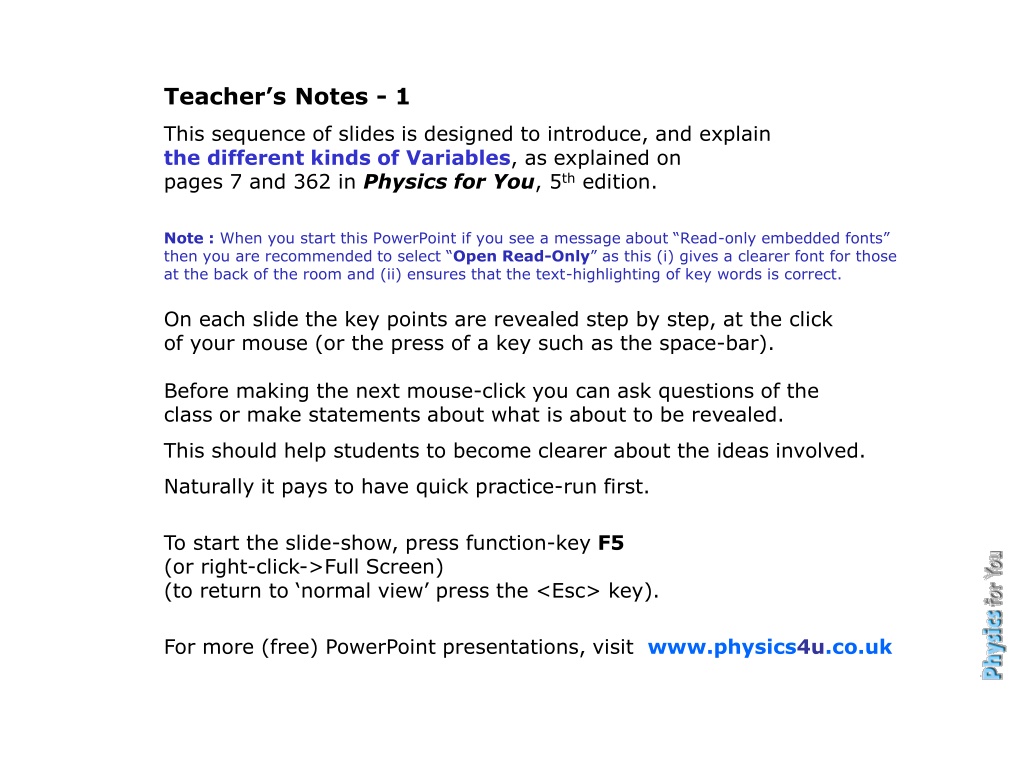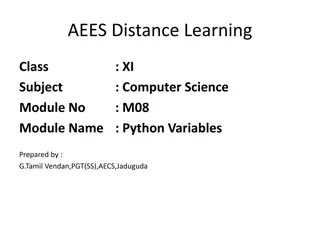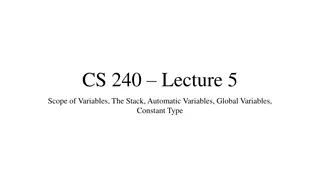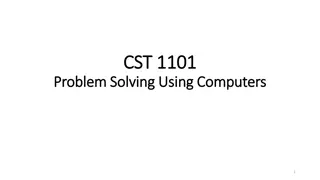Understanding Variables in Physics: A Comprehensive Guide
This presentation introduces and explains different types of variables in Physics, emphasizing the concepts of independent, dependent, and control variables. It provides practical examples and tips for identifying variables in experiments, aiming to enhance students' understanding of scientific methods and principles. The content includes discussions on changing variables, defining input and outcome variables, and highlighting key points for clarity and comprehension.
Download Presentation

Please find below an Image/Link to download the presentation.
The content on the website is provided AS IS for your information and personal use only. It may not be sold, licensed, or shared on other websites without obtaining consent from the author. Download presentation by click this link. If you encounter any issues during the download, it is possible that the publisher has removed the file from their server.
E N D
Presentation Transcript
Teachers Notes - 1 This sequence of slides is designed to introduce, and explain the different kinds of Variables, as explained on pages 7 and 362 in Physics for You, 5th edition. Note : When you start this PowerPoint if you see a message about Read-only embedded fonts then you are recommended to select Open Read-Only as this (i) gives a clearer font for those at the back of the room and (ii) ensures that the text-highlighting of key words is correct. On each slide the key points are revealed step by step, at the click of your mouse (or the press of a key such as the space-bar). Before making the next mouse-click you can ask questions of the class or make statements about what is about to be revealed. This should help students to become clearer about the ideas involved. Naturally it pays to have quick practice-run first. To start the slide-show, press function-key F5 (or right-click->Full Screen) (to return to normal view press the <Esc> key). For more (free) PowerPoint presentations, visit www.physics4u.co.uk
Teachers Notes - 2 In order to anticipate any awkward questions from students on this topic, it may be helpful to consider the following points, which arose out of a discussion on the Institute of Physics NewsGroup: --In Example 1 (stretching an elastic band) it shows the weight (independent variable) changing the elastic s length (dependent variable). But you could just as easily say that you were changing the length of the elastic (independent) and then measuring how much weight was needed (dependent). --The simplest rule is to emphasise that the variable that YOU change is the independent (or input) variable. --Many students would find it easier to use the terms input variable and outcome variable, as these are more descriptive but the UK exam specifications (and exam papers) do not use these terms. --In Example 3 (current in a circuit) the voltage is increased by adding more cells. You could say that the number of cells is the independent variable (assumes that the cells are identical). (This would be an example of a discrete variable.)
Working Scientifically: Variables Physics for You, 5th edition, pages 7 and 362
Learning Objectives You should learn : About the different types of variables, How to identify them when doing your practical work.
Variables Variables are things that vary and change
Variables In any experiment there are 3 variables: an independent (or input) variable a dependent (or outcome) variable some control variables Let s look at each type .
Independent (input) variable This is the thing that you decide to change. Example 1 Investigating how a weight affects the length of an elastic band. You decide the weight to apply, so: Weight is the independent variable.
Independent (input) variable This is the thing that you decide to change. Example 2 Investigating how the rate of cooling of a beaker depends on the initial temperature. You decide the initial temperature, so: initial temperature is the independent variable.
Independent (input) variable This is the thing that you decide to change. Example 3 Investigating how the current through a resistor depends on the voltage across it. Which is the independent variable as you add cells? The voltage is the independent variable.
Dependent (outcome) variable This is the variable that changes as a result. It is the variable that you measure. Example 1 Investigating how a weight affects the length of an elastic band. You measure the resulting length of the elastic band, so: Length is the dependent variable.
Dependent (outcome) variable This is the variable that changes as a result. It is the variable that you measure. Example 2 Investigating how the rate of cooling of a beaker depends on the initial temperature. You measure the temperature every minute as it cools, so: temperature is the dependent variable.
Dependent (outcome) variable This is the variable that changes as a result. It is the variable that you measure. Example 3 Investigating how the current through a resistor depends on the voltage across it. Which is the dependent variable here? The current is the dependent variable.
Control variables These are all the variables that must not change, to make sure it is a fair test. Example 1 Investigating how a weight affects the length of an elastic band. You must use the same elastic band all the time, and the same scale etc, so it is a fair test.
Control variables These are all the variables that must not change, to make sure it is a fair test. Example 2 Investigating how the rate of cooling of a beaker depends on the initial temperature. You must use the same beaker, with the same amount of water, in the same position in the room, at the same room temperature, so it is a fair test.
Control variables These are all the variables that must not change, to make sure it is a fair test. Example 3 Investigating how the current through a resistor depends on the voltage across it. Which are the control variables here? Use the same circuit at the same temperature each time.
Tables When you draw up a table of your results, the independent variable goes in the first column, like this: If you take several readings of the dependent variable, then you can calculate the mean (average) Then your results will be more accurate.
In Summary Example 1 The independent variable is ? weight The dependent variable is ? length of the elastic The control variables are ?same elastic band, same scale, etc, so it is a fair test.
In Summary Example 2 The independent variable is ? initial temperature The dependent variable is ? temperature as it cools The control variables are ? the same beaker, with the same amount of water, in the same position in the room, at the same room temperature, so it is a fair test.
In Summary Example 3 The independent variable is ? voltage (p.d.) The dependent variable is ? current The control variables are ?the same circuit, at the same temperature each time, so it is a fair test.
Learning Outcomes You should now: Understand the difference between - independent, - dependent, and - control variables Be able to identify these variables when doing your practical work.
For more details, see: Physics for You, 5th edition, pages 7, 362 For more free PowerPoints, visit the web-site at www.physics4u.co.uk
If you are connected to the web at the moment, click below to see what s available: http://www.physics4u.co.uk/























